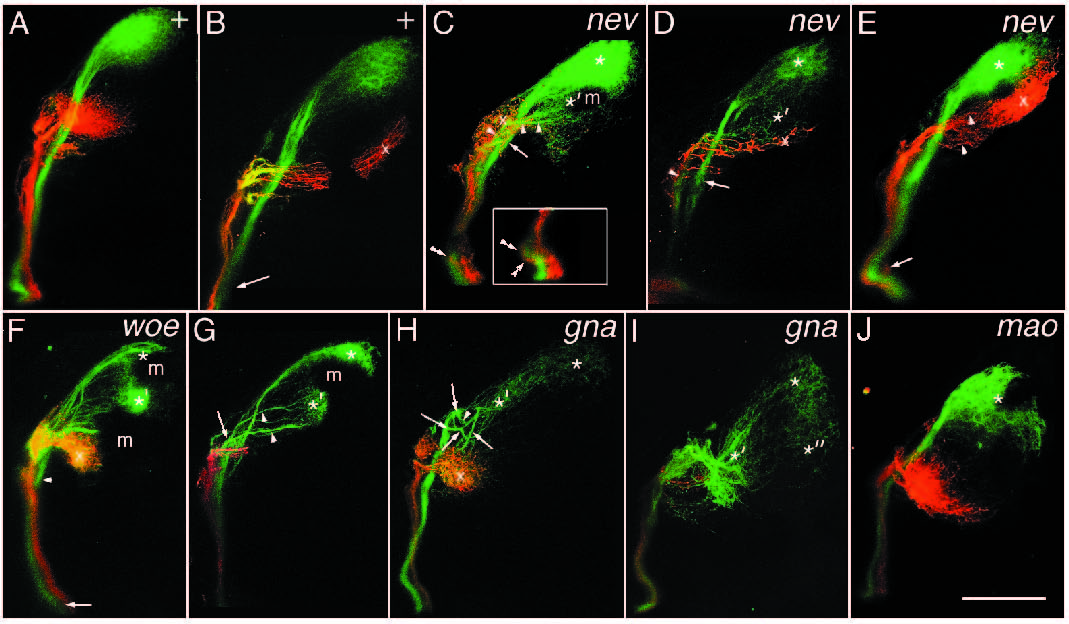Fig. 6
Mutations affecting the mapping of RGC axons. All images shown in this figure are projections of optical sections obtained with a confocal microscope. (A) Retinotectal projection of a wild-type fish. The absolute position of the termination areas on the tectum cannot be seen, but the temporoventral axons (red) terminate anterior and dorsal of the nasodorsal axons (green), as is typical for a wild-type projection. For all the confocal images shown, the absolute positions of the termination fields has been ascertained using conventional fluorescence microscopy. (B) Retinotectal projection of another wild-type fish. In this animal, red axons are of nasoventral origin and terminate in the posterodorsal tectum (x). Note that the dorsal and ventral axons, although both originating in the nasal retina, still occupy different parts of the optic nerve (arrow). (C) In nev mutants, nasodorsal axons terminate posteroventrally (*) and posterodorsally (*′) in the tectum. Temporoventral axons terminate retinotopically in the anterodorsal tectum (x). The nasodorsal axons grow through both the ventral (arrow) and the dorsal (arrowheads) branch of the optic tract. RGC axons are already missorted in the optic nerve. Some of the temporoventral axons grow ectopically in the anterior portion of the optic nerve (double arrowheads). The inlet shows the optic nerve of another nev mutant individual showing a similar phenotype. (D) Another nev mutant fish. This picture shows more clearly that the nasodorsal axons grow in the ventral (arrow) and the dorsal (arrowhead) branches of the optic tract. The nasodorsal axons terminate again in the posteroventral (*) and posterodorsal (*′) tectum. Nasoventral axons (red) terminate retinotopically in the posteroventral tectum (x). (E) Nasoventral axons (red) in nev mutants always terminate correctly in the dorsal tectum (x), but reach their target area on meandering paths (arrowheads). A subpopulation of the nasoventral axons grows ectopically in the posterior portion of the optic nerve (arrow). Compare with B. In this individual, the nasodorsal axons terminate correctly in the ventral tectum, but the termination area is larger and fuzzier than in wild-type fish. (F) A woe mutant fish. Nasodorsal axons terminate on the ventral (*) and the dorsal (*′) side of the tectum. Note that the majority of the nasodorsal axons appear to terminate at the ectopic dorsal side. Temporoventral axons terminate retinotopically in the anterodorsal tectum (x). The RGC axons are normally sorted in the optic nerve (arrow) and tract (arrowhead), but the nasodorsal and the temporoventral fascicles cross each other further away from the eye than usual. The two branches of the tract itself are less widely searated than in wild-type animals. G: Another woe mutant fish. Nasodorsal axons (green) terminate again in the posteroventral (*) and the posterodorsal (*′) tectum. Nasodorsal axons split only upon reaching the tectum (arrow). Ectopic nasodorsal axons grow in several fascicles along the dorsal margin of the tectum (arrowheads). (H) Retinotectal projection of a gna mutant fish. The termination area of the nasodorsal axons is enlarged and encompasses posteroventral (*) and anteroventral (*′) parts of the tectum. The nasodorsal fascicle splits abruptly into several smaller fascicles upon reaching the tectum (arrows), some of which turn sharply dorsally before continuing to the posterior tectum (arrowhead). Temporoventral axons terminate correctly in the anterodorsal tectum (x). The sorting of the axons along the optic nerve and tract is normal. (I) In some gna mutant fish, nasodorsal axons terminate not only anteroventral (*′) and posteroventral (*), but also posterodorsal (*′′). (J) A mao mutant fish. The termination area, especially of the nasodorsal axons (*), is larger and fuzzier than in wild type. m, melanophore. Scale bar, 0.1 mm.

